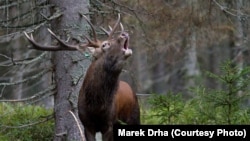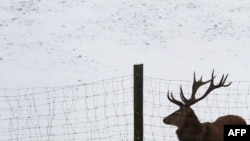The barbed wire, electric fences, watchtowers, and heavily-armed guards that once lined the Iron Curtain are long gone, but red deer wouldn't dare jump the border.
Behavior learned at the height of the Cold War lives on among the herds that roam land that used to straddle the former Czechoslovakia and West Germany.
The once heavily fortified borders separating East from West today traverse national parks and remote landscapes that serve as popular summertime migratory destinations for the imposing beast.
In the spirit of post-Cold War fellowship, Germany's Bavarian Forest National Park and the Czech Republic's Sumava National Park established a transboundary wilderness area where animals like the red deer could find refuge.
But as it turns out, the deer populations on either side of the former Iron Curtain roam along the border and remain reluctant to cross.
Using GPS satellite collars, Czech zoologists, in cooperation with their German colleagues, monitored the migration patterns of red deer on either side of the border between 2005 and 2011.
The results of the study were released in the Czech Republic recently in a book titled "Deer In Sumava."
The head of the Czech team, Pavel Sustr, says researchers found that the migratory patterns of the approximately 1,800 deer that live in Sumava differ little from those followed by their ancestors decades ago.
"It's going to absolutely the same place in the following years," Sustr says. "And because of this traditional behavior, they are still somehow respecting the former Iron [Curtain]."
He notes that some deer are making the leap into uncharted territory, but the winds of change blow slowly in the mountains of Central Europe.
"More animals in the last year are crossing [the border], but the trend, or the change, is quite slow because of the traditional behavior of the deer," Sustr says. "The young deer [during its] first year follows its mother [and] the mother is teaching [it] the area. So, more or less, the behavior of the mother [determines] the area which is used by the deer in later years."
Behavior learned at the height of the Cold War lives on among the herds that roam land that used to straddle the former Czechoslovakia and West Germany.
The once heavily fortified borders separating East from West today traverse national parks and remote landscapes that serve as popular summertime migratory destinations for the imposing beast.
In the spirit of post-Cold War fellowship, Germany's Bavarian Forest National Park and the Czech Republic's Sumava National Park established a transboundary wilderness area where animals like the red deer could find refuge.
But as it turns out, the deer populations on either side of the former Iron Curtain roam along the border and remain reluctant to cross.
Using GPS satellite collars, Czech zoologists, in cooperation with their German colleagues, monitored the migration patterns of red deer on either side of the border between 2005 and 2011.
The results of the study were released in the Czech Republic recently in a book titled "Deer In Sumava."
The head of the Czech team, Pavel Sustr, says researchers found that the migratory patterns of the approximately 1,800 deer that live in Sumava differ little from those followed by their ancestors decades ago.
"It's going to absolutely the same place in the following years," Sustr says. "And because of this traditional behavior, they are still somehow respecting the former Iron [Curtain]."
He notes that some deer are making the leap into uncharted territory, but the winds of change blow slowly in the mountains of Central Europe.
"More animals in the last year are crossing [the border], but the trend, or the change, is quite slow because of the traditional behavior of the deer," Sustr says. "The young deer [during its] first year follows its mother [and] the mother is teaching [it] the area. So, more or less, the behavior of the mother [determines] the area which is used by the deer in later years."

